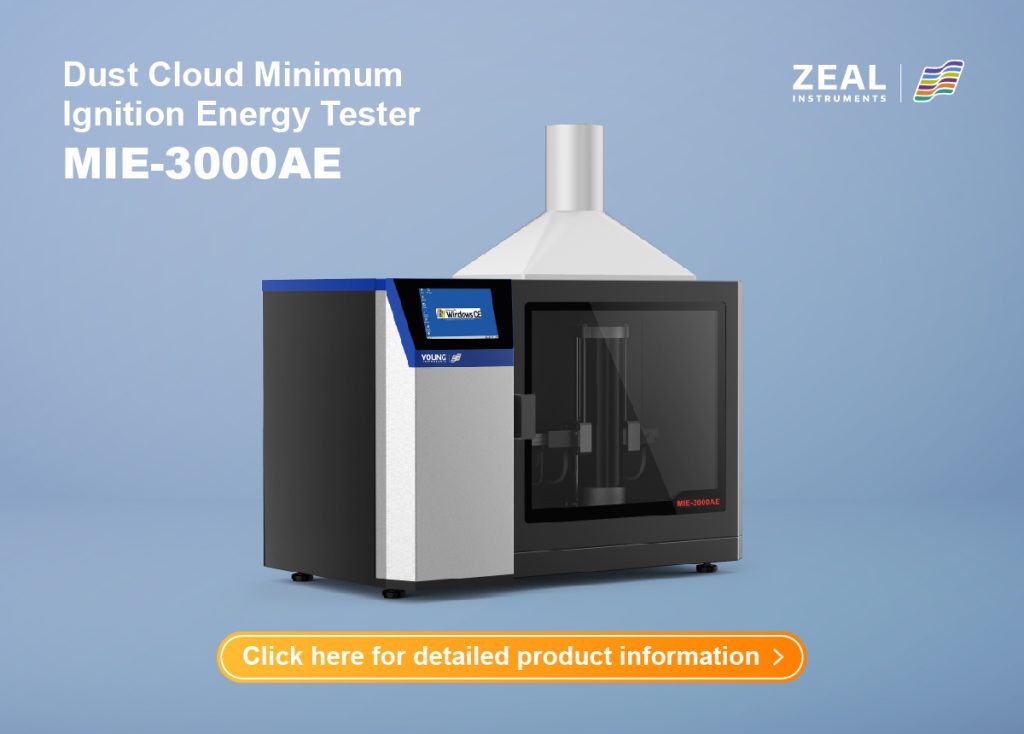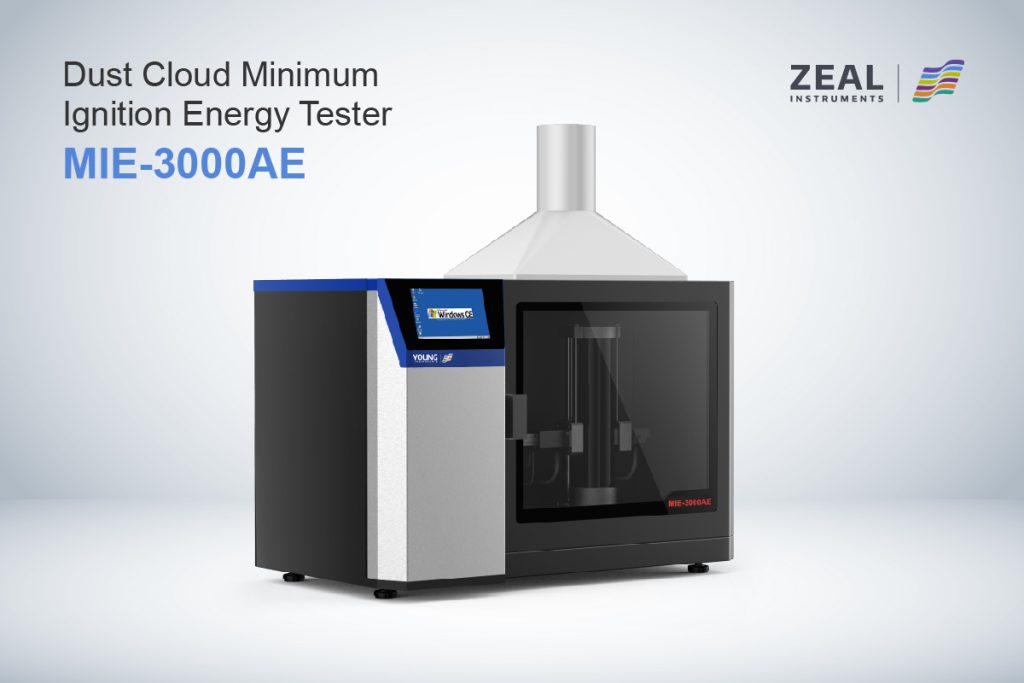Why Accurate Minimum Ignition Energy Testing is Essential for Industrial Dust Safety
Minimum Ignition Energy refers to the smallest amount of energy required to ignite a combustible mixture of dust and air. When flammable dust particles mix with air, they form an explosive atmosphere, which can lead to combustion or explosions if provided with an adequate ignition source. The energy provided by this ignition source is the ignition energy. The Minimum Ignition Energy varies depending on the proportion of dust and air in the mixture, with the minimum ignition energy occurring when the ratio is optimal for combustion.
Minimum Ignition Energy is a critical parameter that reflects the ease with which a dust and air mixture can ignite. Dust with a lower it is more prone to ignition, making it essential to carefully monitor and mitigate the risks associated with such materials in industrial settings. The lower the Minimum Ignition Energy, the higher the risk of explosion, making Minimum Ignition Energy a crucial factor in designing safe processes and implementing effective safety measures.

Testing Instruments for Minimum Ignition Energy
Dust Cloud Minimum Ignition Energy Tester (Minimum Ignition Energy-3000AE)
The Minimum Ignition Energy-3000AE is a state-of-the-art instrument designed to determine the Minimum Ignition Energy of combustible dust clouds. It utilizes compressed air to disperse a specific mass of dust into a Hartmann tube, where it forms a dust cloud. This cloud is then ignited using controlled spark energy, and it is measured through repeated testing.
This instrument reflects the dust’s sensitivity to ignition from an energy perspective, offering valuable insights into the potential explosion hazards of dust clouds. The Minimum Ignition Energy-3000AE meets international testing standards such as ASTM E2019, IEC 61241-2-3, and ISO/IEC 80079-20-2, making it suitable for various industrial applications.
Key Features
Automated Operation: The Minimum Ignition Energy-3000AE is designed for ease of use, with automatic selection of the optimal capacitor and voltage combination for each test.
Safety Enhancements: The device features an automatic high-voltage charging module disconnection, ensuring safe operation for lab personnel. Additionally, a remote ignition control system is available, further reducing the risk to operators during testing.
Efficient Design: The Hartmann tube’s lifting and rotating mechanism allows for easy cleaning, saving time between experiments. Moreover, the dust dispersion device ensures even distribution of dust samples, leading to more accurate and repeatable results.
Data Management: A USB plug-and-play interface makes it convenient to manage and store test data, while the user-friendly 7-inch LCD touchscreen displays the experiment’s progress in real time.

Factors Affecting Minimum Ignition Energy
Dust Type and Composition
The type of dust plays a significant role in determining its Minimum Ignition Energy. Different materials have different ignition properties due to their chemical compositions. Organic materials like sugar, flour, and coal are typically more combustible than metals or inorganic compounds. Moreover, even the same material can have a wide range of it values based on factors such as particle size, moisture content, and the presence of volatile gases.
For instance, dust particles with a smaller average size are generally more reactive and easier to ignite than larger particles. This is because smaller particles have a higher surface area relative to their mass, allowing more efficient heat transfer during combustion. Therefore, industries handling fine powders need to pay extra attention to the risk of dust explosions.
Environmental Conditions
Several environmental factors can influence the Minimum Ignition Energy of a dust cloud. The moisture content of the dust is one such factor, as higher moisture levels can raise the it by making ignition more difficult. On the other hand, extremely dry conditions can lower the it, increasing the risk of explosions.
The concentration of oxygen in the air also plays a vital role. Higher oxygen levels typically result in lower Minimum Ignition Energy values, meaning that a more oxygen-rich environment is more susceptible to combustion. Additionally, the presence of flammable gases or vapors can further reduce the it, increasing the overall hazard.
Experimentation and Testing
Due to the variability across different materials and environmental conditions, the most reliable method to determine the Minimum Ignition Energy of a specific dust sample is through laboratory testing. Instruments such as the Dust Cloud Minimum Ignition Energy Tester (Minimum Ignition Energy-3000AE) are used to measure the it of dust clouds accurately.
The testing process involves dispersing a measured amount of dust into a Hartmann tube, where it is ignited using a specified spark energy. By conducting a series of tests, the lowest energy required to ignite the dust cloud is identified. This data is then used to evaluate the potential explosion risks associated with handling the material.
Importance of Minimum Ignition Energy in Industrial Safety
Managing Dust Explosion Hazards
Understanding the Minimum Ignition Energy of dust is essential for managing dust explosion risks in various industries, particularly those involving manufacturing, food processing, or chemicals. A lower it means that even a small amount of energy—such as a spark from static electricity—can trigger an explosion. As a result, industries handling dust with low values must take extra precautions, including designing explosion-proof equipment, grounding machinery, and minimizing the accumulation of dust.
For example, dust with a Minimum Ignition Energy of less than 2 mJ poses a significant risk and requires the same level of caution as handling highly flammable liquids. In such cases, facilities may need to implement nitrogen inerting systems, ensure proper grounding, and avoid the use of insulating materials.
Designing Safe Systems
In systems where dust with low Minimum Ignition Energy values is handled, it is essential to incorporate safety features that prevent ignition sources from coming into contact with the dust-air mixture. Grounding and bonding of equipment to prevent static discharge is one of the most effective measures. For dusts with it values between 2 mJ and 10 mJ, facilities need to ensure that all conductive components are grounded, and personnel handling the materials are properly grounded as well. Moreover, the use of anti-static plastic bags and conductive containers is recommended to minimize the risks associated with static buildup.
For materials with their values above 10 mJ, while the risk of ignition is lower, safety precautions should still be in place. As long as it remains below 500 mJ, there remains a potential for ignition by static electricity, and grounding measures must be observed. Dusts with a Minimum Ignition Energy above 500 mJ are less likely to be ignited by static electricity, but facilities should still follow standard grounding and bonding procedures to maintain a safe working environment.
Conclusion
Supplier Information
Hangzhou Zeal Instruments Science & Technology Co., Ltd. supplies the Minimum Ignition Energy-3000AE and other advanced testing instruments for determining the it of dust clouds. Their products are widely used in industries that need to assess explosion risks related to combustible dust. With a commitment to safety and innovation, they provide reliable solutions for managing dust explosion hazards.
Final Thoughts
Understanding the it of combustible dust is critical in preventing industrial explosions. By considering factors such as dust type, environmental conditions, and conducting proper testing, industries can design safer systems and reduce the risk of catastrophic dust explosions. Utilizing advanced instruments like the Minimum Ignition Energy-3000AE allows companies to assess and manage these risks effectively, ensuring the safety of both their personnel and facilities.






































